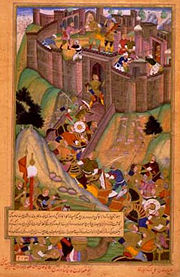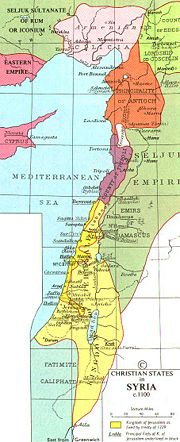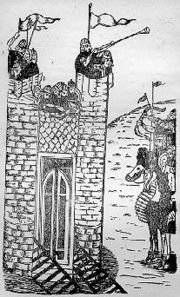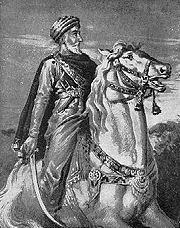Hashshashin

The Hashshashin (also Hashishin, Hashashiyyin, or Hashasheen) from which the word Assassins is thought to originate, were the military wing of the Nizari branch of the Ismā'īlī Shia Muslims following a dispute regarding the succession of the eighth Fatimide Caliph Al Mustansir. The Nizāriyya, upheld Nizar to be the rightful successor but the faction were driven from Egypt. However the majority of Isma'ili outside of the Fatmid State believed that Nizar was the rightful successor, and established a number of fortified settlements in present day Iran, Iraq, Syria and Lebanon, the first of which was Alamut under the charismatic Iranian leader Hasan-i Sabbah. Persecuted as infidels by the dominant Sunni sect in the Muslim world, they sent dedicated people to eliminate prominent Sunni leaders, whom they considered "impious usurpers."[1] [2] The sect was decimated by the invading Mongols, their last stronghold being seized by Hülegü Khan in the year 1272.
The term Hashshashin, a name given to them by their Arab enemies, was derived from the Arabic "haššāšīn" (حشّاشين, "hashish user"). It also means the ones who produce hashish, which they are alleged to have ingested prior to their attacks, but this etymology is disputed. The sect referred to themselves as al-da'wa al-jadīda (Arabic:الدعوة الجديدة), which means the new doctrine, and were known within the organization as Fedayeen.
Contents |
History of the Hashshashin

Although apparently known as early as the 8th century, the federation of the Assassins is usually marked as 1090 when Hasan-i Sabbah established his stronghold in the Daylam mountains south of the Caspian Sea at Alamut. Hasan set the aim of the Assassins to destroy the power of the Abbasid Caliphate by murdering its most powerful members. Much of the current western lore surrounding the Assassins roots from Marco Polo's supposed visit to Alamut in 1273, which is widely considered fictional (especially as the stronghold had reportedly been destroyed by the Mongols in 1256).
Benjamin of Tudela who traveled one hundred years before Marco Polo mentions the Al-Hashshashin and their leader as "the Old Man." He notes their principal city to be Qadmous.
The members were organized into rigid classes, based upon their initiation into the secrets of the order. The devotees constituted a class that sought martyrdom and followed orders with unquestioned devotion, orders which included assassination. Because of the secretive nature of the order, it has often been invoked in conspiracy theories.
Notable victims include, Nizam al-Mulk (1092; although some historical sources contradict this claim), the Fatimad vizier al-Afdal (1122), ibn al-Khashshab of Aleppo (1124), il-Bursuqi of Mosul (1126), Raymond II of Tripoli (1152), Conrad of Montferrat (1192), and Prince Edward, later Edward I of England was wounded by a poisoned assassin dagger in 1271. It is believed that Saladin, incensed by several almost successful Hashshashin attempts on his life, besieged their chief Syrian stronghold of Masyaf during his reconquest of Outremer in 1176 but quickly lifted the siege after parley, and thereafter attempted to maintain good relations with the sect. The sect's own extant accounts tell of Rashid ad-Din Sinan, stealing into Saladin's tent in the heart of his camp, and leaving a poisoned cake and a note saying "You are in our power" on Saladin's chest as he slept. Another account tells of a letter sent to Saladin's maternal uncle, vowing death to the entire royal line, perhaps no idle threat; whatever the truth of these accounts (and likely it will remain a mystery) he clearly heeded their warning, and desisted.
The Hashshashin were often motivated by outsiders. The murder of the Patriarch of Jerusalem, for example, was instigated by the Hospitallers. It is rumoured the assassination of Conrad of Montferrat may have even been hired by Richard the Lionheart. In most cases they were aimed at retaining the balance of the Hashshashin's enemies.

The power of the Hashshashin was destroyed by the Mongol warlord Hulagu Khan, but several Ismaili sects share something of a common lineage. During the Mongol assault of Alamut on 1256 December 15, the library of the sect was destroyed, along with much of their power base, and thus much of the sect's own records were lost; most accounts of them stem from the highly reputable Arab historians of the period. The Syrian branch of the Hashshashin was destroyed in 1273 by the Mamluk Sultan Baybars. The Hashshashin, in 1275, captured and held Alamut for a few months but their political power was lost and they were eventually absorbed into other Isma'ilite groups. They continued being used under the Mamluks, Ibn Battuta recording in the 14th century their fixed rate of pay per murder.
Description
|
|
|
|---|---|
| Concepts | |
|
The Qur'ān · The Ginans |
|
| Seven Pillars | |
|
Guardianship · Prayer · Charity |
|
| Early Imams | |
|
Ali · Ḥassan · Ḥusain |
|
| History | |
|
Shoaib · Nabi Shu'ayb |
|
| Branches | |
|
Nizārī · Musta‘lī · Druze |
|

Most Muslim contemporaries were obviously suspicious of these "Holy Killers"; in fact they were described using the term Batini. The term was sometimes used pejoratively to refer to those, especially Ismaili, who discerned an inner, esoteric level of meaning (batin) in the Qur'an. This constant religious estrangement would eventually see them go so far as allying with the Occidental Christians against Muslims on a number of occasions.
The original place they started their elite group was in Alamut, Iran (Persia) and later traveled to other countries. Legends abound as to the tactics used to induct warriors into what became both a religious and a political organization. One such False legend is that future assassins were subjected to rites similar to those of other mystery cults, in which the subject was made to believe that he was in imminent danger of death. The twist was that they were drugged to simulate "dying", to later awaken in a garden flowing with wine and served a sumptuous feast by virgins. The supplicant was then convinced he was in Heaven and that the cult's leader, Hasan-i Sabbah, was a representative of the divinity and all his orders should be followed, even unto death. This legend derives from Marco Polo, who visited Alamut after it fell to the Mongols in the thirteenth century, and never mentioned in contemporary Ismaili sources, nor from rival Sunnis and Shia, despite them suffering from the assassination acts of that rival sect. For example, Daftary says: "At the same time, within the crusading-culture of a pre- and early-modern Europe, the Syrian and Persian Nizaris took shape as Muslim mercenaries-cum-fanatics who murdered their victims while high on opium or hashish. If this propagandist concoction of a 'stoned' assassin fails to fit the complex reality of the discipline and training required for committing what was always an explicitly political act, the popular notion of Nizaris as a community of killers also denies their rich, multivalent culture." and Edward Burman, in his The Assassins - Holy Killers of Islam says: "There is no mention of that drug [hashish] in connection with the Persian Assassins - especially in the library of Alamut ('the secret archives')." As well, Encyclopedia of the Orient refutes this allegation. See also here.
The group transformed the act of murder into a system directed largely against Seljuk Muslim rulers who had been persecuting their sects. They were meticulous in killing the targeted individual, seeking to do so without any additional casualties and innocent loss of life, although they were careful to cultivate their terrifying reputation by slaying their victims in public, often in mosques. Typically, they approached using a disguise. Preferring a small hidden blade or dagger, they rejected poison, bows and other weapons that allowed the attacker to escape and live. For unarmed combat, the Hashshashin practiced a fighting style called Janna which incorporates striking techniques, grappling and low kicks. However, under no circumstances did they commit suicide, preferring to be killed by the master himself.
There are also, possibly apocryphal, stories that they used their well-known deadliness for political goals without necessarily killing. For example, a victim, usually high-placed, might one morning find a Hashshashin dagger lying on their pillow upon awakening. This was a plain hint to the targeted individual that he was not safe anywhere, that maybe even his inner group of servants had been infiltrated by the assassins, and that whatever course of action had brought him into conflict with them would have to be stopped if he wanted to live.
Etymology of the word "assassin"
The name "assassin" is commonly believed to be a mutation of the Persian haššāšīn (حشّاشين); however, there are those who dispute this etymology, arguing that it originates from Marco Polo's account of his visit to Alamut in 1273[3] It is suggested by some writers that assassin simply means 'followers of Hassan' (or Hasan-i Sabbah, the Sheikh of Alamut (see below)).
The word Hashish (of probable Persian origin) refers to resin collected from cannabis flowers. The true meaning of the word in Persian is actually "healers" or "herb sellers" .
Nevertheless, the most acceptable etymology of the word assassin is the simple one, it comes from Hassan (Hasan ibn al-Sabbah) and his followers, and so had it been for centuries. The noise around the hashish version was invented in 1809, in Paris, by the French orientalist Sylvestre de Sacy, whom on July the 7th of that year, presented a lecture at the Academy of Inscriptions and Fine Letters (Académie des inscriptions et belles lettres) –part of the Institute of France- in which he retook the Marco Polo chronicle concerning drugs and this sect of murderers, and associated it with the word. Curiously his theory had great success and apparently still has.
– Jacques Boudet, , Les mots de l’histoire}, Ed. Larousse-Bordas, Paris, 1998
Many scholars have argued, and demonstrated convincingly, that the attribution of the epithet 'hashish eaters' or 'hashish takers' is a misnomer derived from enemies of the Isma'ilis and was never used by Muslim chroniclers or sources. It was therefore used in a pejorative sense of 'enemies' or 'disreputable people'. This sense of the term survived into modern times with the common Egyptian usage of the term Hashasheen in the 1930s to mean simply 'noisy or riotous'. It is unlikely that the austere Hasan-i Sabbah indulged personally in drug taking. ...There is no mention of that drug [hashish] in connection with the Persian Assassins - especially in the library of Alamut ("the secret archives").
– Edward Burman, The Assassins - Holy Killers of Islam
Another variation on the theory described by Burman above is that haššāšīn was a derogatory epithet applied by the Assassins' Syrian neighbors due to the Assassins' behavior or their secretive, heterodox theology, meaning "crazy people," as in "those people who are addled, as if by cannabis."
See also
- Nizari the religious branch the Hashashin belonged to
- Aga Khan IV the current leader of the Nizari Isma'ili
- Ainsarii
- Sicarii
- Knights Templar
- Alamut - novel by Vladimir Bartol
- Sufism
References
- ↑ Daftary (1999). The Isma'ilis: their History and Doctrines. Cambridge University Press. pp. 324–338. ISBN 0-521-42974-9.
- ↑ Lewis, Bernard (1967). The Assassins: A Radical Sect in Islam. Weidenfeld & Nicholson. ISBN 0-465-00498-9.
- ↑ Polo, Marco. The Travels of Marco Polo. Plain Label Books. ISBN 1-603-03300-9.
Bibliography
- Burman, Edward (1987). The Assassins. Wellingborough: Crucible. ISBN 1-852-74027-2.
- Daftary, Farhad (1990). The Isma'ilies, Their History and Doctrines. Cambridge: Cambridge University Press. ISBN 0-521-37019-1.
- Daftary, Farhad (1995). The Assassin Legends: Myths of the Ismailis. London: I.B. Tauris. pp. 88–127. ISBN 1-850-43950-8. "Review".
- Franzius, Enno (1969). History of the Order of Assassins. New York: Funk & Wagnalls.
- Hodgson, Marshall G.S. (1955). The Secret Order of Assassins: The Struggle of the Early Nizârî Ismâʻîlîs Against the Islamic World. The Hague: Mouton. ISBN 0-8122-1916-3. http://books.google.com/books?id=C3crAAAAIAAJ&dq=The+Order+of+Assassins&pgis=1.
- Maalouf, Amin (1989). The Crusades Through Arab Eyes (translated by Jon Rothschild ed.). New York: Schocken Books. ISBN 0-805-20898-4.
- Polo, Marco (1903). H. Cordier. ed.. The Book of Ser Marco Polo, volume 1 (3rd revised translated by H. Yule ed.). London: J. Murray. pp. 139–146. http://books.google.com/books?id=vsKY2uImEiEC&printsec.
- Silvestre de Sacy, A.L. (1818). "Mémoire sur La Dynastie des Assassins, et sur L’Etymologie de leur Nom". Memoires de sins, et sur l’Institut Royal de France 4: 1–84. "English translation in F. Daftary, The Assassin Legends, 136-188.".
- Stark, Freya (2001). The Valleys of the Assassins and Other Persian Travels. New York: Modern Library. ISBN 0-375-75753-8.
- Willey, Peter (1963). The Castles of the Assassins. London: George G. Harrap.
External links
- The Crusades Wiki
